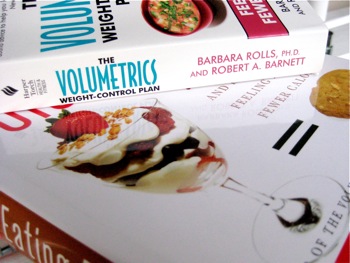A huge, two-cup bowl of minestrone? (220 calories)
or
One third of a Whopper with cheese? (253 calories)
Hmm.
 Welcome to the world of energy density. It's the concept at the heart of the Volumetrics weight-control plan, but many diet plans employ the same basic idea. It's a concept that can help you learn to make healthy food choices that won't leave your tummy unsatisfied.
Welcome to the world of energy density. It's the concept at the heart of the Volumetrics weight-control plan, but many diet plans employ the same basic idea. It's a concept that can help you learn to make healthy food choices that won't leave your tummy unsatisfied.I write often about the advantages of replacing the salty or sugary snack foods with fruit. I've also discussed how important it is to eat plenty of beans. In my meal plans, I often include pasta with vegetables (whether they be broccoli florets stirred in or chunky tomatoes in a hearty sauce). But why? All of these strategies are based in part on evaluating the energy density of foods.
So what exactly is energy density, and what does it mean for those of us looking to reach a healthy weight? Barbara Rolls, nutrition professor at Penn State, writes in The Volumetrics Weight-Control Plan:
If you are trying to consume fewer calories, what is critical is the amount of calories in a given portion of food. A food that is of high energy density provides a large amount of calories in a small weight, while a food of low energy density has fewer calories for the same weight. With food of lower energy density, you can eat a larger portion for the same calories. (p. 15)
A food's energy density, then, is the ratio of its calories to its weight (as measured in grams). To calculate it, divide the number of calories on the nutrition label by the number of grams given for that serving.
Energy Density = Food Calories/Grams
That minestrone soup I mentioned above has 110 calories for a 241-gram serving. Its energy density, then, is a low 0.5 calories per gram. You can eat a lot of it without taking in too many calories.
The Whopper with cheese has 760 calories in one 315-gram sandwich. That gives it a high energy density of 2.4 calories per gram, which means you'll consume a ton of calories before you've eaten a satisfying serving.
It turns out that people don't decide how much food to eat based on calorie counts (surprise, surprise) but rather on food weight. Rolls found in her research that people tend to eat the same weight of food every day, no matter what kind of food it was.
That means your body would feel equally satisfied with either a pound of soup or a pound of cheeseburger. If you choose foods with low energy densities, then, you can continue eating your normal daily weight of food (so you won't feel hungry) and still drop pounds.
Calculating energy density does require a little math (albeit not as much as calculating Weight Watchers points!), but the good news is that a little knowledge about food components makes it easy to estimate which foods will have low energy density.
Many people know that a gram of fat has more calories (nine) than a gram of protein or carbs (four). Additionally, a gram of alcohol has eight calories, and a gram of water has none. None!
Water-based foods, such as most fruits, vegetables, and soups, have the lowest energy density. Foods high in fat, such as meats and full-fat dairy, tend to have high energy density. You can judge what foods are the best low-cal choices, then, by which are likeliest to be mostly water.
Another quick trick is to check the nutrition label:
- If there are fewer calories than grams in a serving, the food has low energy density and can be eaten in abundance. Examples: squash, strawberries, oatmeal
- If the number of calories is close to the number of grams, it has middling energy density and should be eaten with some restraint. Examples: pasta, potatoes, shrimp
- If the number of calories exceeds the number of grams, you're looking at a food with high energy density, and you should eat it only in moderation. Examples: chips, hot dogs, cheddar cheese
Energy density is only one factor that should go into choosing what you eat; people cannot live by watermelon alone. However, you can use this stat to help you make healthy snack choices and to make your favorite dishes more waistline friendly. Give it a try today!
Next week, we'll look in a little more detail at using energy density to eat more of the foods we love for fewer calories.
Photo: Colleen Fischer
Technorati Tags:
diet, dieting, food, healthy eating, nutrition, weight loss, Volumetrics, energy density




No comments:
Post a Comment